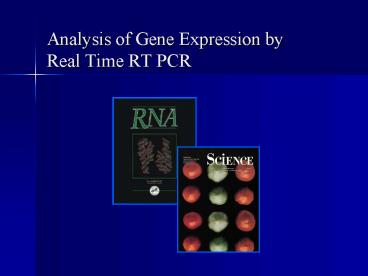Analysis of Gene Expression by Real Time RT PCR - PowerPoint PPT Presentation
1 / 11
Title:
Analysis of Gene Expression by Real Time RT PCR
Description:
To characterize the expression of ribulose 1-5 bisphosphate carboxylase ... Cell Lysis. Cells harvested (1 gm) Cell lysis accomplished via grinding in liquid nitrogen ... – PowerPoint PPT presentation
Number of Views:307
Avg rating:3.0/5.0
Title: Analysis of Gene Expression by Real Time RT PCR
1
Analysis of Gene Expression by Real Time RT PCR
2
Broad and Long Term Objective
- To characterize the expression of ribulose 1-5
bisphosphate carboxylase oxygenase and
chlorophyll AB binding gene in Lycopersicon
esculentum (Tomato) leaves subjected to 24, 28,
and 72 hours in the dark
3
Research Plan
RNA Isolation leaf material grown in light and in
the dark
RNA Electrophoresis and cDNA synthesis
Assessing Gene Expression Northern Blot
RNase Protection Quantitative PCR
Quantitative real time RT PCR
4
Todays Laboratory Objectives
- To isolate high quality total RNA from tomato
leaf tissue (growth conditions include light and
24, 48, or 72 hr dark) - To quantitate the amount and purity of the total
RNA isolated - To become familiar with the nuances in handling
RNA
5
RNases ARE EVERYWHERE!
- Control of RNases
- Wear Gloves and Practice Sterile Technique
- Use Disposable Plastics or Baked Glassware
- Use chemicals or reagents that will inactive
RNAses (DEPC treated water, chaotropic agents,
etc) - Always Keep RNA on Ice or Frozen
- Work quickly and carefully
6
RNA Extraction Procedure
Harvest Tissues
- Lyse Cells and Inhibit RNAses
Separate RNA from Other Cellular Macromolecules
Precipitate RNA
7
Guanidinium Isothiocyanate ExtractionCell Lysis
- Cells harvested (1 gm)
- Cell lysis accomplished via grinding in liquid
nitrogen - Guanidinium thiocyanate chaotropic agent
inhibits RNases - Sarkosyl disrupts membranes and inhibits
ribonucelases - B-mercaptoethanol reduces disulfide bonds of
RNAses and prevents free-radical crosslinking of
phenolics to DNA
8
Phenol Chloroform Extraction
Phenol pH 4.3 Hydroylzes DNA Denatures
Proteins Complexes Lipids/CHOs While RNA remains
in Aqueous Phase
9
Precipitation of RNA
Principle Need enough salt to neutralize the
repulsion among the negatively charged strands of
DNA, and enough alcohol to pull water molecules
out of the DNA strand. Lithium Chloride-
selectively precipitates RNA Isopropanol more
effective for smaller amounts of nucelic acids
10
UV Spectrophotometry for Quantitating Amount and
Purity of RNA
- To Quantify your RNA sample
- A260 x Dilution Factor x 40 ug/ml
concentration of nucleic acids in a sample
using a 1 cm pathlength - To estimate the purity of your sample
- A260/A280 ratio of nucleic acids/protein
- A260/A280 1.8-2.1 is optimal for RNA
11
Next Week
- RNA Electrophoresis
cDNA Synthesis































